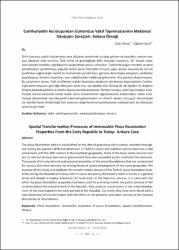| dc.contributor.author | Aksoy, Zafer | |
| dc.contributor.author | Varol, Çiğdem | |
| dc.date.accessioned | 2016-03-09T12:27:09Z | |
| dc.date.available | 2016-03-09T12:27:09Z | |
| dc.date.issued | 2015-12 | |
| dc.identifier.citation | AKSOY, Zafer & Çiğdem VAROL, "Cumhuriyetin Kuruluşundan Günümüze Vakıf Taşınmazlarının Mekânsal
Dönüşüm Süreçleri: Ankara Örneği", Vakıflar Dergisi, 44 (2015): 105-129. | en_US |
| dc.identifier.uri | http://www.vgm.gov.tr/vgmdergi/dergiindex.aspx?Id=1 | |
| dc.identifier.uri | https://hdl.handle.net/11352/2303 | |
| dc.description.abstract | Tarih boyunca çeşitli toplumlarda aynı düşünce temelinde kurulup gelişen ve karşılıksız yardım esasına
dayanan vakıf kurumu, Türk kültür ve geleneğinde farklı boyutlar kazanmış, 20. Yüzyıla kadar
olan süreçte Anadolu coğrafyasının vazgeçilmez unsuru olmuştur. Türkiye’de bugün merkezi ve yerel
yönetimlerce yürütülmeye çalışılan temel kamu hizmetlerinin pek çoğu, asırlar boyunca bu kurum
tarafından sağlanmıştır. Gerek bu hizmetlerin yürütülmesi, gerekse daha başka amaçlarla vakfedilen
yapılı/yapısız binlerce taşınmaz, aynı coğrafyadaki mekânsal gelişmenin itici gücünü oluşturmuştur.
Bu çalışmanın amacı, Türk vakıflarının mekân boyutunu oluşturan söz konusu taşınmazların Cumhuriyet
tarihi boyunca geçirdiği dönüşüm sürecinin, üst ölçekte tüm Türkiye’de alt ölçekte ise Başkent
Ankara özelinde politika ve mekân boyutuyla irdelenmesidir. Tarihsel süreçte, vakıf taşınmazları Cumhuriyet
öncesi dönemde temel olarak kamu hizmetlerinin sağlanmasında kullanılırken, erken Cumhuriyet
döneminde yeni Başkent’in kentsel gelişimindeki en önemli aktörü olmuştur. Günümüzde
ise Vakıflar Genel Müdürlüğü’nün taşınmaz değerlendirme politikalarının etkisiyle yeni bir dönüşüm
sürecine girmiştir. | en_US |
| dc.description.abstract | The pious foundation which is established by the idea of gratuitous aid in various societies throughout
history has gained a different dimension in Turkish culture and tradition and has become a vital
component until the 20th century in the Anatolian geography. Many of the basic public services that
are carried out by local and central government have been provided by this institution for centuries.
Thousands of structured and unstructured properties of the pious foundations that are consecrated
for various aims have become the driving forces of spatial development of the same geography. The
purpose of this study is to explicate the transformation process of the Turkish pious foundation properties
during the Republican history with its space and policy dimensions, both in Turkey in a general
sense and deeply in Capital Ankara in the local scale. In the historical process, it is observed that
while the pious foundation properties had been used for providing mainly the public services of the
societies before the establishment of the Republic, they acted as crucial actors in the urban development
of the new Capital in the early periods of the Republic. Currently, they have been faced with a
new dimension of transformation with the effect of the property evaluation policies of the General
Directorate of Foundations. | en_US |
| dc.language.iso | tur | en_US |
| dc.publisher | Vakıflar Genel Müdürlüğü | en_US |
| dc.rights | info:eu-repo/semantics/openAccess | en_US |
| dc.subject | Vakıf | en_US |
| dc.subject | Vakıf Taşınmazları | en_US |
| dc.subject | Mekânsal Dönüşüm | en_US |
| dc.subject | Ankara | en_US |
| dc.subject | Pious Foundation | en_US |
| dc.subject | Immovable Properties of Pious Foundations | en_US |
| dc.subject | Spatial Transformation | en_US |
| dc.title | Cumhuriyetin Kuruluşundan Günümüze Vakıf Taşınmazlarının Mekânsal Dönüşüm Süreçleri: Ankara Örneği | en_US |
| dc.title.alternative | Spatial Transformation Processes of Immovable Pious Foundation Properties From the Early Republic to Today: Ankara Case | en_US |
| dc.type | article | en_US |
| dc.contributor.department | Vakıflar Genel Müdürlüğü Yayınları | en_US |
| dc.relation.publicationcategory | Makale - Ulusal Hakemli Dergi - Başka Kurum Yazarı | en_US |



















